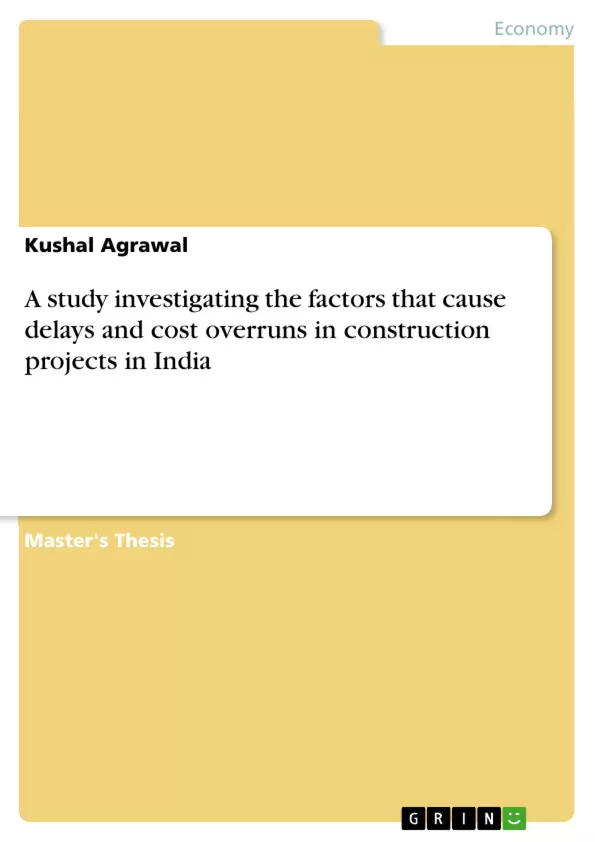Anyone who has got a rework or renovation work done in their house can tell you what a troublesome activity it is. Not only that, it seems to take forever to be completed and is heavy on the wallet. Even an international icon like the Sydney Opera house, which has always been Australia’s pride, was delayed by 10 years with its budget shooting up by 14.5 times its estimated budget of $7 million. There are plenty of such examples available. It is very common for construction projects to get delayed and outrun their budget. This is a tough scenario faced by almost all projects around the world, with India not being an exception. Thus, the researcher has undertaken this research to investigate the factors responsible for delays and cost overruns. Both secondary research and primary research have been carried out and the barriers have been identified. Such barriers create problems that hinder the efficiency and progress of a project, making it lag behind its schedule. The factors identified in the secondary research are compared to the findings of the primary research to see if they hold true in the Indian context.
Inhaltsverzeichnis (Table of Contents)
- CHAPTER 1: INTRODUCTION
- 1.1 Introduction
- 1.2 Background
- 1.3 Research aims and Question
- 1.3.1 Research aim
- 1.3.2 Research Question
- 1.4 Organization of the study
- CHAPTER 2: LITERATURE REVIEW
- 2.1 Introduction
- 2.2 Basic concepts of a project and project management
- 2.3 Aligning the project with the business strategy
- 2.4 Assessing the project
- 2.5 Project implementation
- 2.6 Factors causing delays in the construction industry
- 2.6.1 Lack of commitment
- 2.6.2 Inefficient site management
- 2.6.3 Poor site coordination
- 2.6.4 Improper planning
- 2.6.5 Lack of clarity in project scope
- 2.6.6 Lack of communication
- 2.6.7 Sub-standard contract
- 2.7 Summary
- CHAPTER 3: METHODOLOGY
- 3.1 Research philosophy
- 3.1.1 Epistemological considerations
- 3.1.2 Ontological considerations
- 3.1.3 Axiological Considerations
- 3.2 Research approach
- 3.3 Research method
- 3.4 Research design and strategy
- 3.5 Time Horizon
- 3.6 Research instrument
- 3.7 Sampling
- 3.8 Data analysis
- 3.9 Ethical concerns
- 3.10 Summary
- CHAPTER 4: FINDINGS AND ANALYSIS
- 4.1 Introduction
- 4.2 Factors identified
- 4.2.1 Problems related to government and authorities
- 4.2.2 Problems related to the contractor
- 4.2.3 Problems related to labor
- 4.2.4 Problems related to materials and equipment
- 4.2.5 Problems related to design
- 4.2.6 Problems related to finance
Zielsetzung und Themenschwerpunkte (Objectives and Key Themes)
The dissertation aims to investigate the factors responsible for delays and cost overruns in construction projects in India. The research combines both secondary and primary research methods to identify the barriers that hinder project efficiency and progress. The study explores the Indian context by comparing findings from secondary research with those obtained through primary research. Key themes explored in the text include:- The significance of the construction industry in India's economic growth
- The prevalent issues of delays and cost overruns in construction projects
- The identification of key factors contributing to these issues
- The exploration of these factors within the specific context of the Indian construction industry
- A comprehensive analysis of the research findings
Zusammenfassung der Kapitel (Chapter Summaries)
- Chapter 1: Introduction This chapter sets the foundation for the research by outlining the importance of the construction industry in India's development. It highlights the rapid growth of the sector and its significant contribution to the country's GDP. Evidence is provided to demonstrate the widespread issues of delays and cost overruns within the industry.
- Chapter 2: Literature Review This chapter delves into existing literature on project management and the factors contributing to delays in the construction industry. It explores key concepts such as project alignment with business strategy, project assessment, and implementation. The chapter also examines various factors that commonly lead to delays, including lack of commitment, inefficient site management, poor coordination, improper planning, unclear project scope, communication breakdowns, and sub-standard contracts.
- Chapter 3: Methodology This chapter outlines the research methodology employed in the study. It discusses the chosen research philosophy, including epistemological, ontological, and axiological considerations. The research approach, method, design and strategy, time horizon, research instruments, sampling techniques, data analysis methods, and ethical concerns are also addressed in detail.
- Chapter 4: Findings and Analysis This chapter presents the results of the research, focusing on the factors identified as contributing to delays and cost overruns. It explores problems related to government and authorities, contractors, labor, materials and equipment, design, and finance. The findings are analyzed and discussed in relation to the existing literature and the specific context of the Indian construction industry.
Schlüsselwörter (Keywords)
The dissertation focuses on the critical factors responsible for delays and cost overruns in the Indian construction industry. The study examines the complexities of project management in this sector, exploring the role of government policies, contractor practices, labor dynamics, material availability, design considerations, and financial constraints. The research utilizes both secondary and primary data analysis to provide a comprehensive understanding of the challenges faced by the Indian construction industry.- Citar trabajo
- Kushal Agrawal (Autor), 2013, A study investigating the factors that cause delays and cost overruns in construction projects in India, Múnich, GRIN Verlag, https://www.grin.com/document/265883



